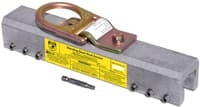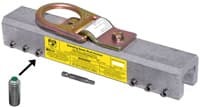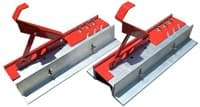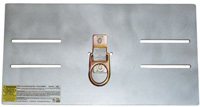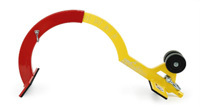Fall Protection Anchors For Peak Metal Rooofing
Posted by Howie Scarboro - CEO Fall Protection Distributors, LLC on Apr 9th 2025
See the Roof Anchor Compatibility Chart for Peak Metal Roofing Standing Seam Panels.

Who Is Peak Metal Roofing?
Peak Metal Roofing, a family-owned business based in Hancock, Michigan, specializes in custom steel panel manufacturing for roofing and siding, serving the Upper Peninsula of Michigan and Northern Wisconsin. Founded by a family with nearly two decades of roofing installation experience in Montana, the company was born from a desire to bring high-quality, locally made metal solutions to the Keweenaw Peninsula. After relocating, they established themselves as the region’s only metal roofing, siding, and trim manufacturer, leveraging their expertise to craft products tailored to withstand the area’s harsh weather—think heavy snow, fierce winds, and extreme cold. Their history of hands-on roofing work informs every aspect of their production, ensuring durability and precision in every panel they create.
At the heart of their operation is a focus on steel panel manufacturing, offering a range of options like AG Panels, Standing Seam Panels (both Mechanical Lock and Snap-Lock varieties), and Board and Batten siding. These panels come in multiple gauges—22, 24, 26, and 29—crafted from painted steel with a 40-year limited paint warranty, alongside other materials like aluminum, copper, and stainless steel. Their state-of-the-art facility can produce custom-length panels quickly, often within 1-2 days if materials are in stock, or about a week if a new metal coil is needed. This speed, paired with their ability to bend custom trim up to 22 gauge, makes them a go-to for contractors, homeowners, and DIY enthusiasts seeking reliable, long-lasting building materials.
Peak Metal Roofing prides itself on quality and local commitment, guaranteeing scratch- and dent-free steel panels that stand the test of time. While they don’t handle delivery or installation, their 18+ years of roofing know-how allow them to guide customers and connect them with trusted installers. Their manufacturing process reflects a blend of modern technology and old-school craftsmanship, honed from years in the field. With a wide array of colors and finishes, they cater to diverse aesthetic needs, ensuring every project—big or small—gets the same attention to detail that’s defined their family business from the start.
Since launching, Peak Metal Roofing has aimed to be the preferred steel panel supplier in their region, building a reputation for fast service and top-tier products. Their journey from Montana installers to Michigan manufacturers underscores a dedication to improving homes and supporting the community with solutions built to last. It’s a story of experience meeting innovation, all centered on the art of steel panel production.
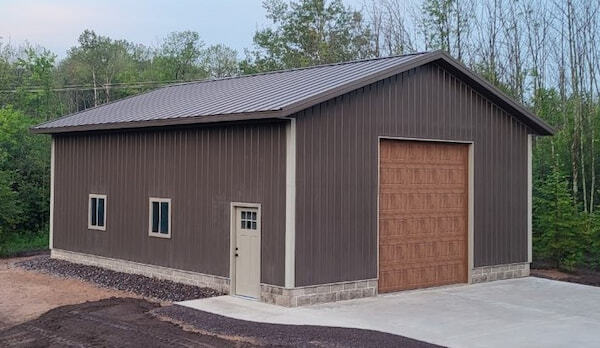
Why Are Compatible Fall Protection Anchors Critical For Standing Seam Roofs?
Standing seam roofs aren’t just sleek and modern—they’re also among the most durable and weather-resistant options out there. But when it comes time to work on them, whether for installation, repairs, or maintenance, things can get risky fast. That’s where compatible fall protection anchors come into play.
Standing seam roofs have unique structural features. Unlike traditional roof systems, they don’t rely on exposed fasteners, which means you can’t just drill into the roof deck and call it a day. Doing so can void warranties, compromise the integrity of the seam, and lead to long-term issues like leaks, rust, or structural failure.
Using a fall protection anchor that’s not engineered for standing seam panels can deform the seam, damage the paint finish, or even collapse under load. That’s why panel-specific compatibility is a requirement—especially when working with premium products like those manufactured by Peak Metal Roofing. Anchors must fit the seam profile, match the panel gauge, and distribute load properly without marring the finish or puncturing the roof.
Properly matched anchors don’t just protect the worker—they protect the investment. For customers who choose standing seam roofing for its longevity and clean appearance, the last thing they want is visible damage or compromised performance caused by improper safety equipment.
The right fall protection solution, when selected based on the panel’s dimensions, material type, and seam shape, will clamp securely without penetration. This allows roofers and maintenance crews to work confidently while maintaining the panel’s structural integrity and warranty.
In the sections that follow, we’ll take a close look at the standing seam options available from Peak Metal Roofing and recommend the most compatible fall protection anchors for each—so you can stay safe without sacrificing the roof’s performance or aesthetics.
Mechanical Lock Panels – 1-Inch or 1.5-Inch Seam Height

Peak Metal Roofing’s Mechanical Lock standing seam panels combine architectural beauty with serious performance. Available in both 1″ and 1.5″ rib heights, these panels are a top-tier choice for both residential and commercial projects where strength, sleek lines, and weather resistance matter. The interlocking seams are secured with a clip system that allows for controlled thermal movement, reducing stress on fasteners and seams over time—especially important in climates like the Upper Peninsula, where freeze-thaw cycles and heavy snow loads are the norm. See the Roof Anchor Compatibility Chart for Peak Metal Roofing Mechanical Lock Standing Seam Panels.
These panels are engineered to span long runs—over 50 feet—without compromising structural integrity. Each panel comes standard with striations for added rigidity and oil canning resistance, though customers can request a smooth finish if desired. The system works on roof pitches as low as 1/12, making it suitable for a wide range of roof geometries.
Peak offers these panels in several durable materials: 22, 24, and 26 gauge painted steel; .032 to .040 painted aluminum; 16 oz. copper; and 26 gauge stainless steel. The paint system includes a 40-year limited warranty, adding peace of mind to the performance package.
Fall Protection For Mechanical Lock Panels
When working on standing seam roofs—especially in climates where ice, wind, and steep pitches are part of the equation—choosing the right fall protection is critical. For Peak’s 22 and 24 gauge steel Mechanical Lock panels, you’ve got one of the best combinations available: the SSRA1 Seam Anchor, the SSRA2 Adjustable Roof Jack, and the SSRA3 Anchor Plate. Together, these components create a no-penetration fall protection setup that keeps workers safe without compromising the panel.
The SSRA1 Seam Anchor attaches directly to the panel seam using a secure clamping mechanism that avoids punctures, preserving both structural integrity and panel warranty. Once installed, it serves as a certified fall arrest anchor rated for 5,000 lbs., compliant with OSHA and ANSI standards.
Add in the SSRA2 Adjustable Roof Jack Adapter, and you can install sturdy 10-foot wooden walk boards between anchors. This makes maneuvering across the roof safer, particularly during extended installs or maintenance work. The roof jacks adjust easily to match seam height, providing a level work platform even on steep slopes.
When more than one worker needs tie-off access, the SSRA3 Anchor Plate mounts on top of the SSRA1 Anchor and supports a temporary horizontal lifeline system. This setup enables multiple users to move along the roofline with continuous fall protection, ideal for crew-based jobs.
If you're working with other substrates—like 26 gauge steel, aluminum, copper, or stainless steel—the Ridge Pro Steep Assist is the way to go, provided the roof has a pitch between 6/12 and 12/12. This anchor doesn’t attach to the seam. Instead, it hooks securely over the ridge of the roof, allowing workers to remain tied off 100% of the time while climbing or working. It’s lightweight, portable, and perfect for quick installs, inspections, or emergency repairs on steep slopes.
Choosing the right anchor system isn’t just about compliance—it’s about keeping your team safe while preserving the long-term performance of high-end roofing systems like these. With the right gear in place, you can protect the crew and the craftsmanship.
Snap-Lock Panels – 1-Inch or 1.5-Inch

Peak Metal Roofing’s Snap-Lock panels with a nailstrip system are a great choice for projects that demand both ease of installation and long-term durability. Available in 1″ or 1.5″ rib heights, these panels feature a hidden fastener system that creates a smooth, uninterrupted roofline while still offering exceptional protection against the elements. The nailstrip design eliminates the need for clips, locking the panel edges into place quickly and securely. See the Roof Anchor Compatibility Chart for Peak Metal Roofing Snap-Lock Standing Seam Panels.
These panels are built to perform. They’re suitable for roofs with a minimum slope of 3/12 and are available in lengths exceeding 50 feet, allowing for clean runs without unnecessary seams or breaks. Striations are standard for added strength and oil canning resistance, though smooth panels can be made by request.
Material options include 22, 24, and 26 gauge painted steel, along with .032 to .040 painted aluminum, 16 oz. copper, and 26 gauge stainless steel. Each material is selected for durability and backed by a 40-year limited paint warranty, ensuring that the appearance holds up just as well as the structure beneath.
Fall Protection For Snap-Lock Panels
Unlike mechanically seamed panels, Snap-Lock panels with a nailstrip edge have a different seam profile and width that don’t provide a proper attachment point for SSRA products. The seam is not structural enough to support the clamp-based anchoring system used by SSRA1, and forcing a fit could damage the panel or result in a fall hazard.
That said, there’s still a safe and effective option. On roofs with a 6/12 to 12/12 pitch, the Ridge Pro Steep Assist anchor can be used to provide fall protection without any need for seam engagement. This system hooks over the ridge of the roof and allows the worker to remain tied off at all times while climbing, navigating, or working on the surface.
The Ridge Pro is especially well-suited for steep Snap-Lock roofs where traditional anchors fall short. It’s portable, quick to deploy, and doesn’t require modification to the roof system, making it a go-to solution for contractors and homeowners tackling projects on nailstrip-style panels.
Using the correct fall protection on Snap-Lock panels is essential—not just for safety compliance, but to avoid damaging the roof and voiding material warranties. With the Ridge Pro, you get reliable safety without compromising the integrity of the roof system.
Standing Seam Metal Roof Anchor Panel Compatibility Chart For Peak Metal Roofing
| Mechanical Lock Panel | Snap-Lock Panel | |
|---|---|---|
| YES | NO | |
| YES | NO | |
| YES | NO | |
| YES | NO | |
| YES | YES |
Contact Us For More Information
For further details on roofing solutions and fall protection systems, contact us at 863-703-4522 or www.StandingSeamRoofAnchor.com. Let's work together to make your roofing projects safe, beautiful, and built to last. For more safety tips, check out OSHA's 48-page fall protection manual. Once you have determined the most suitable anchors for your roof system, download our free Anchor Inspection Form.
Safety Tips For Standing Seam Roofs
Use Specialized Anchor Systems for Standing Seam Roofs
Standing seam roofs require anchors that match their unique design. Non-penetrating seam anchors clamp directly onto the panel seams without damaging the metal or voiding warranties. It's critical to avoid anchors that interfere with hidden clips or structural seams, as improper placement can weaken the system and increase fall risks. Using panel-compatible anchors ensures a secure tie-off and helps maintain the longevity and waterproofing of the roofing system.
Promote a Culture of Safety
Creating a safe job site goes beyond checklists—it’s about mindset and communication. Teams that routinely discuss job hazards, hold regular safety talks, and encourage hazard reporting foster a more alert and unified crew. When workers feel empowered to speak up and take responsibility for each other’s safety, accident rates drop and productivity rises. Safety becomes not just a rulebook, but part of the daily routine.
Equip Workers with High-Quality Safety Gear
Outdated or ill-fitting gear is a recipe for disaster. Workers need harnesses, lanyards, and fall arrest systems that meet OSHA standards and actually fit well enough to wear all day. Consistent inspection and proper adjustment are key. Quality gear not only protects the user but also boosts confidence and focus. When workers trust their equipment, they can move efficiently and stay safer throughout the job.
Encourage the Use of Trauma Straps
When a fall happens, the arrest system kicks in—but what happens next can be just as critical. Trauma straps help workers relieve pressure from their legs, maintain circulation, and stay upright while waiting for rescue. These small additions can drastically reduce the risk of suspension trauma, especially on longer-duration jobs. Every harness should include trauma straps, and workers should be trained on how and when to use them.
Prioritize Ladder Safety Training
Ladder incidents are still one of the most common job site accidents, despite being preventable. Workers need to understand how to position a ladder using the 4-to-1 ratio, secure the base, and maintain three points of contact during use. Routine ladder safety training helps prevent falls when transitioning on or off the roof, keeping job sites safer from the ground up.
Develop OSHA-Compliant Safety Plans
Every roofing job should start with a well-developed safety plan that aligns with OSHA regulations. This plan should spell out fall prevention strategies, emergency procedures, and site-specific risks. Clear documentation helps ensure everyone on-site knows their role and how to respond if something goes wrong. It’s not just about compliance—it’s about having a roadmap for safety from day one.
Set Up Protective Guardrail Barriers for Work Zones
Installing guardrails and warning lines creates a safer perimeter around fall hazards like skylights, access points, and roof edges. These passive protection systems allow workers to operate freely without having to rely solely on personal fall arrest equipment. Properly placed barriers keep work zones clearly defined and reduce the chances of accidental missteps, especially during busy or high-traffic tasks.
Consult Experts for Curved Metal Panels
Curved roofs add architectural flair but complicate fall protection planning. Traditional anchors may not sit securely or perform correctly on curved surfaces. That’s why it’s essential to bring in safety experts when working with these panel styles. They’ll evaluate the structure, identify tie-off points, and recommend the best anchors and lifeline configurations. It’s the safest route for both workers and the roof.
Install Permanent Roof Anchor Systems
Buildings that require frequent roof access benefit from permanent anchor points. These systems provide a ready-made tie-off solution, eliminating the need to install temporary anchors each time maintenance is performed. Ideal for commercial and industrial settings, permanent anchors streamline routine tasks and ensure that safe access is always available—without compromising roof performance.
Ensure Proper Footwear for Stability
Footwear may seem basic, but it plays a big role in worker safety. Roofing crews need boots with excellent grip, solid ankle support, and slip-resistant soles to safely navigate sloped, slick, or uneven surfaces. The right boots can prevent slips and reduce fatigue, helping workers move with confidence even in less-than-ideal weather conditions.
Disclaimer
The views, recommendations, and information presented in this blog are solely those of the author and do not necessarily reflect the opinions or positions of the featured panel manufacturer, its brands, subsidiaries, or parent companies. Customers are strongly encouraged to reach out directly to the roof panel manufacturer for inquiries regarding fall protection compatibility with their products and to address any potential warranty issues that may arise following the installation of our products.


